
BIOS and Overclocking …
Get fast to the right UEFI settings …
ASRock Z390 Extreme4 BIOS and Overclocking
ASRock Z390 Extreme4 UEFI BIOS Update
ASRock Z390 Extreme4 overclocking
ASRock Z390 Extreme4 memory settings
ASRock Z390 Extreme4 voltage settings
ASRock Z390 Extreme4 Overclock even easier
ASRock Z390 Extreme4 BIOS undervolting
ASRock Z390 Extreme4 Fan control
BIOS and overclocking …
Let us continue with the BIOS / UEFI Setup options and the UEFI overclocking. After switching on the PC, press the Del or F2 key to access the UEFI setup.
The ASRock Z390 Extreme4 UEFI has a graphical interface that allows intuitive operation with the mouse or can still be operated conventionally with a keyboard.
As usual at the latest ASRock motherboards, there is the ASRock EZ Mode – Easy Mode – which offers a clear input page with a lot of important information and still does not seem overloaded. It has Basic information such as time, date, CPU temperature, mainboard temperature, CPU voltage, first details about hardware, fan speed, hard disk configuration, RAID mode and fan settings with one click.
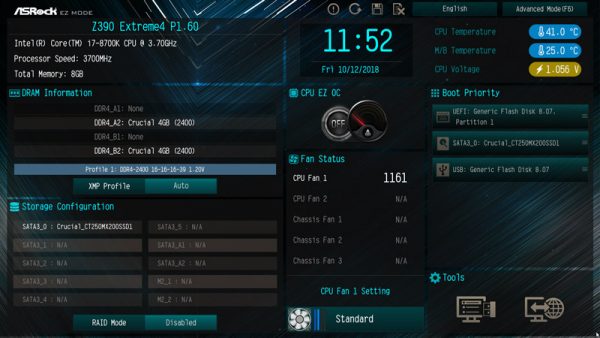
In addition, a few applications have been combined in one tools page.
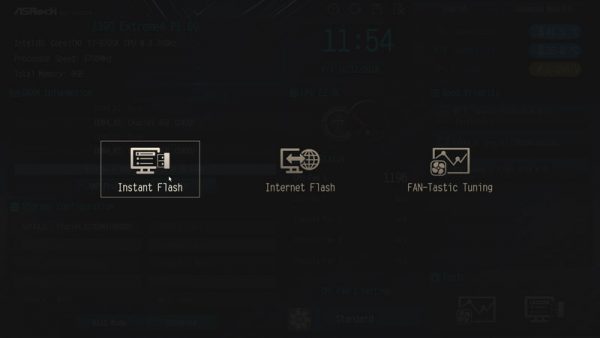
Of course you can also use the EZ menu to set the time and date.
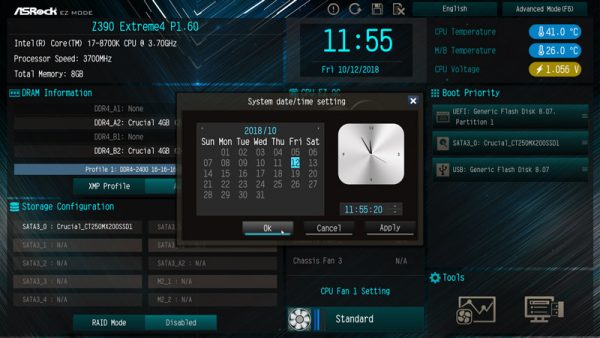
Many other functions can be operated using function keys, which can be called by pressing F1.
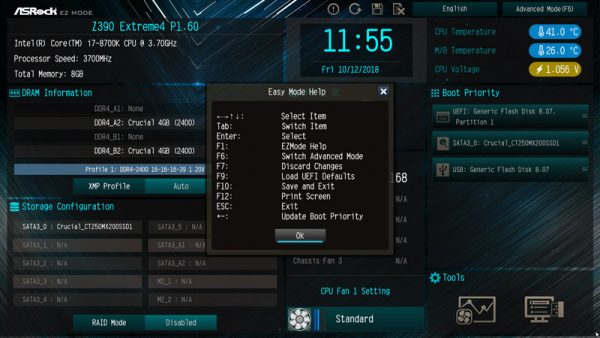
With the F6 key or the upper right button you get to the usual ASRock Advanced Mode, which you can also set as default.
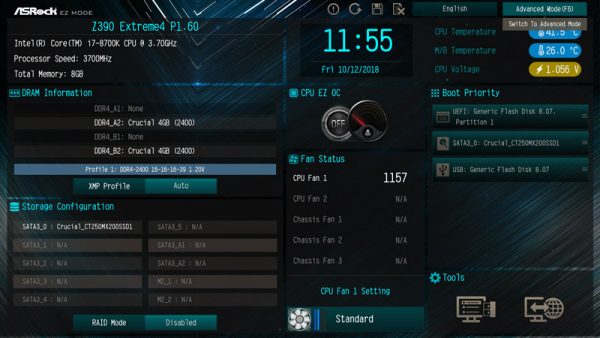
The System Browser view at the ASRock Z390 Extreme4 motherboard can’t be found, but you will find the Full HD UEFI selection and the Active Page on Entry selection, where you can decide on which UEFI page you want to start in the UEFI setup. On the ASRock Z390 Extreme4 you will find the Active Page on Entry option and the Full HD UEFI selection in Advanced.
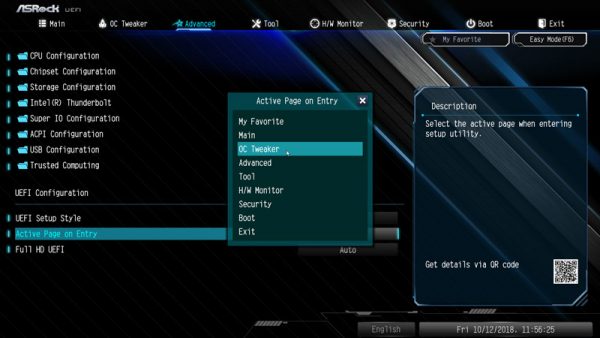
UEFI BIOS Update …
Before we start with UEFI overclocking, we update the UEFI BIOS to the latest version. Since ASRock regularly integrates new functions, better memory support and new processors, the BIOS update is recommended in most cases. For flashing the UEFI update ASRock offers several possibilities, e.g. the very simple Instant Flash or even the ASRock Internet Flash with a direct connection to the Internet. Via the so-called ASRock Instant Flash Option in the Tool Screen or via the F6 key when starting the PC you can access the ASRock Instant Flash Utility. You can simply install a previously downloaded ASRock BIOS without boot CD or similar by starting the ASRock Instant Flash Utility. Then select the BIOS Flash ROM from the desired drive, e.g. from a USB stick, which you have to unpack after downloading.
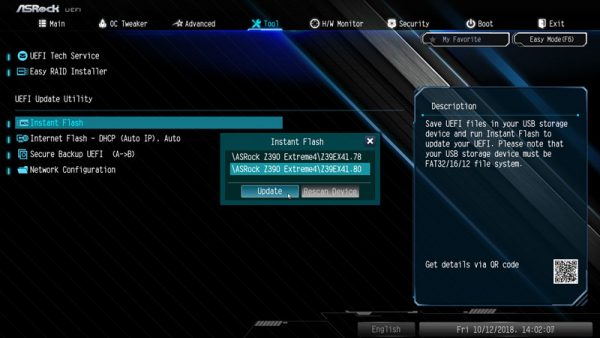
At the time of testing the UEFI BIOS version P1.80 was available as the latest download, which we installed immediately over the pre-installed BIOS P1.60.
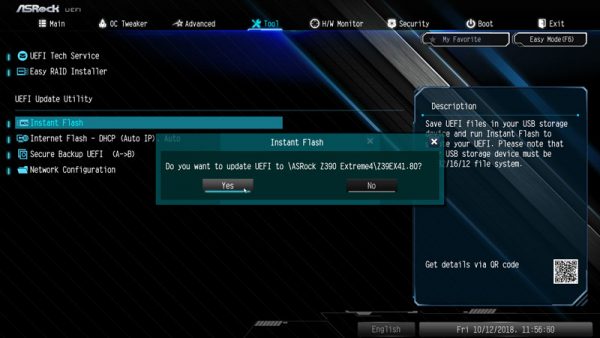
After a reboot the new BIOS version P1.80 is available.
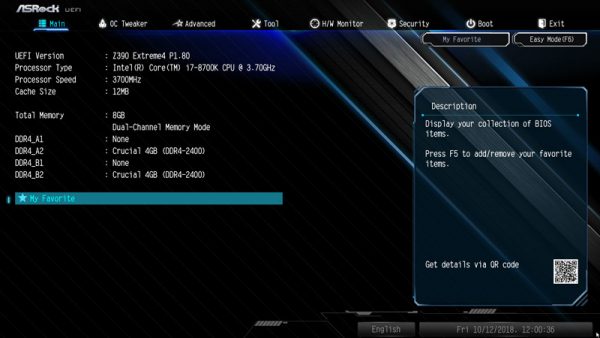
The My Favorite function is very helpful because it allows you to place frequently used menu items here, so that you can see them easily on a page and access them faster. You start with a blank page – by the way, it will be emptied after a BIOS update.
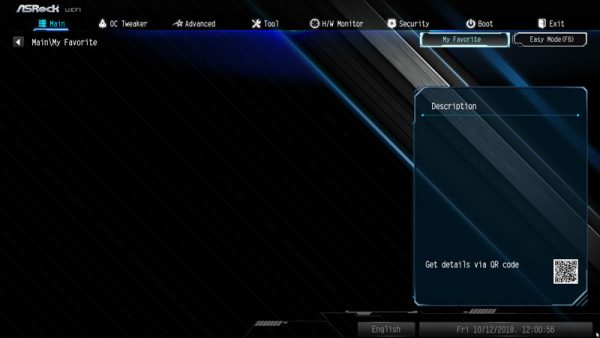
The My Favorite page can now be filled with your own menu items by simply going to the respective menu item, then pressing F5 and the desired functions are already included in the My Favorite overview page. Here you can see a selection of possible favorites.
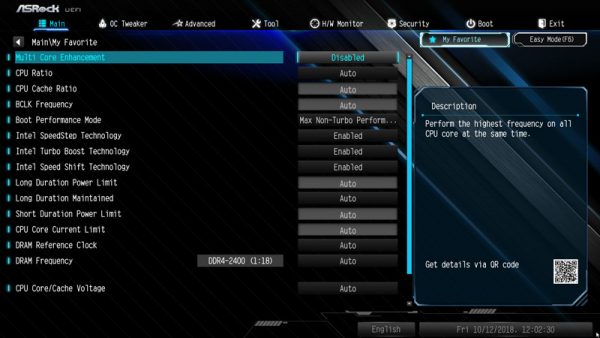
There is no RGB LED entry for this ASRock Z390 Extreme4 Mainboard, although it has the RGB connectors.
If you need technical UEFI support, you can even contact the ASRock Tech Service via the UEFI setup via network connection.
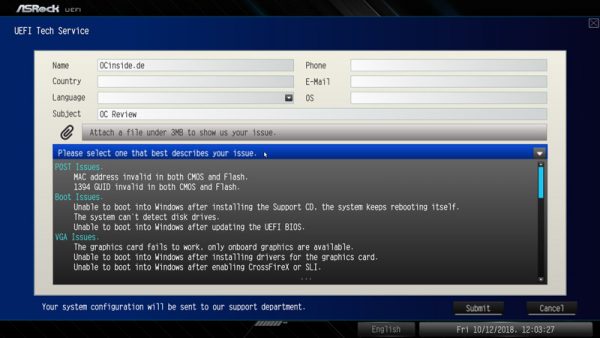
ASRock Z390M doesn’t offer an Easy Driver Installer option, but ASRock makes the RAID driver installation very easy for the user by offering with the Easy RAID Installer the easy way to download the current RAID drivers.
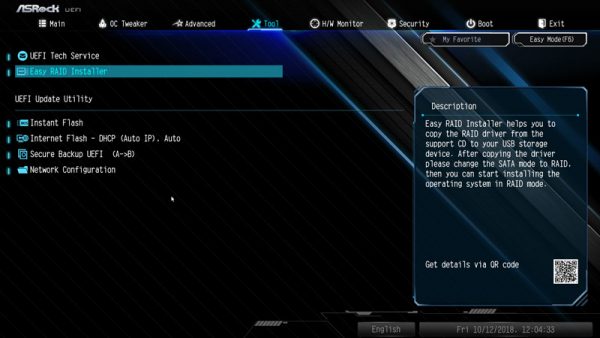
ASRock Z390 Extreme4 Overclocking …
Now let’s get to Intel LGA 1151 overclocking with the Z390 chipset on the ASRock Z390 Extreme4 motherboard. ASRock splits the OC-Tweaker menu into CPU Configuration, DRAM Configuration and Voltage Configuration.
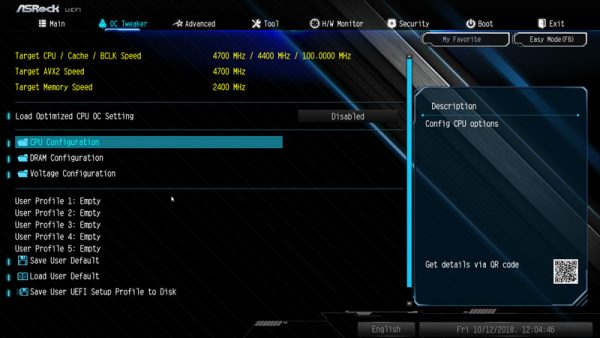
In contrast to the Intel H370 chipset, the motherboard with Intel Z390 chipset can finally be overclocked again!
A look into the CPU configuration shows numerous OC options for Intel LGA1151 v2 CPU overclocking.
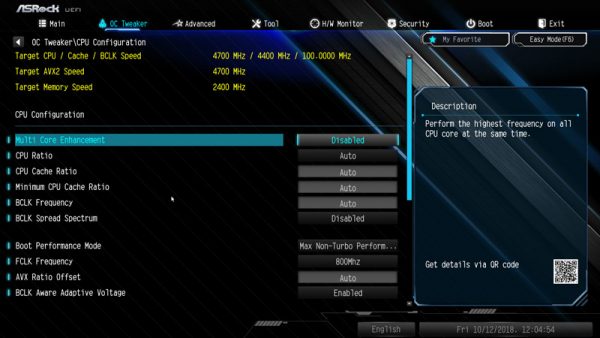
The BCLK/PCIE frequency can be set from 100 MHz up to an incredible 500 MHz. Of course, Intel LGA1151-2 processors also use this frequency to calculate a large number of parameters that can quickly become too high. For this reason, the BCLK host clock should only be increased with caution.
In our test, the board could be overclocked up to an incredible 350 MHz! BCLK!
Intel K processors have an unlocked multiplier, so that the desired CPU frequency can be increased via the CPU multiplier. With the 8700K CPU (standard clock 3700MHz with a CPU ratio of 37x) the ASRock Z390 Extreme4 motherboard offered a multiplier range from 8x to 83x. Beside the CPU Ratio and BCLK Settings there are of course many other setting options.
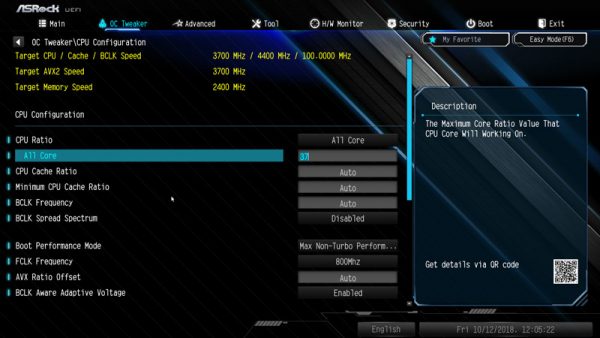
We tried out how easy overclocking is with the Intel Core i7-8700K CPU, and as reported in Intel OC Forum at Intel Core i7-8700K OC, we got from 3700 MHz to 5300 MHz. Here you can see the confirmed CPU-Z tool with 5300 MHz at 1.4500 Volt (Auto +0.2V). However, the cooling for a longer operation under load should be improved significantly, because the air cooler quickly reaches its limits.
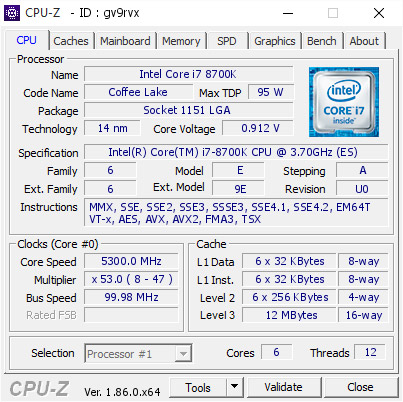
Beside the CPU Ratio and BCLK Settings there are of course many other settings.
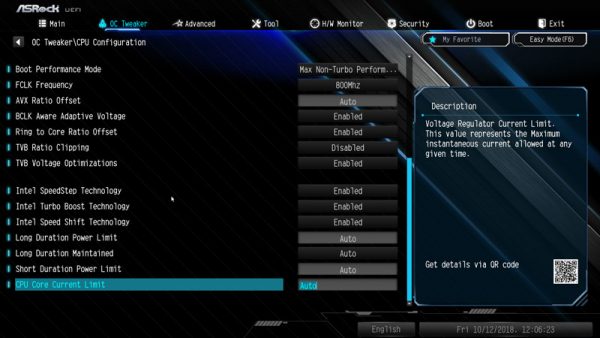
ASRock Z390 Extreme4 memory settings …
In the DRAM configuration menu you can find all important memory settings.
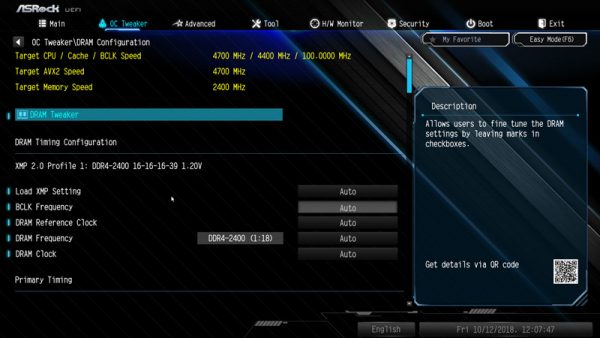
Thanks to Load XMP Setting support, XMP memory modules are already correctly set with a mouse click in the UEFI BIOS.
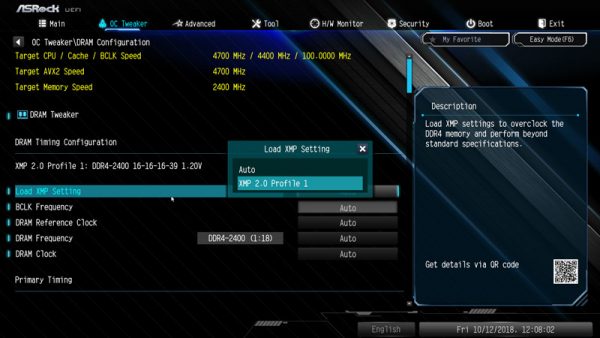
Alternatively you can select the settings manually. With the DDR4 memory clocking you can e.g. select values from DDR4-800 …
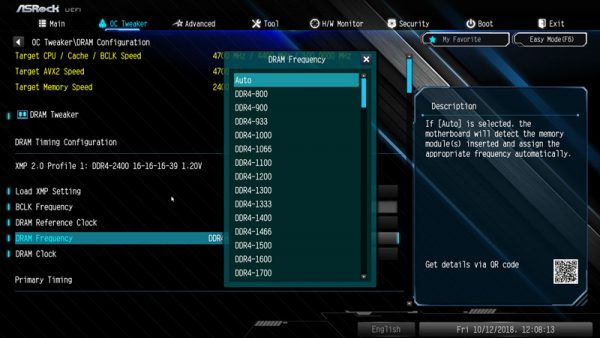
… to DDR4-8400, where the BCLK is then increased.
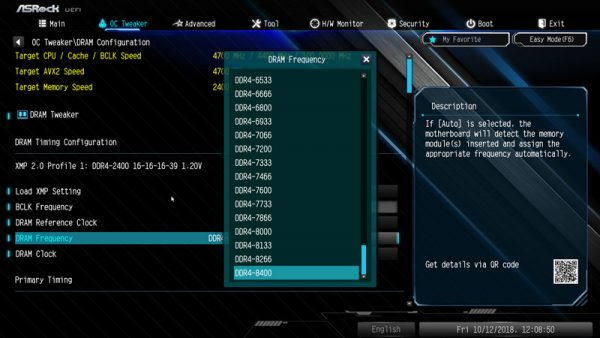
All DDR4 timings can also be adjusted manually.

The ASRock Z390 Extreme4 also offers a DRAM tweaker menu with all SPD and XMP memory values for direct selection.
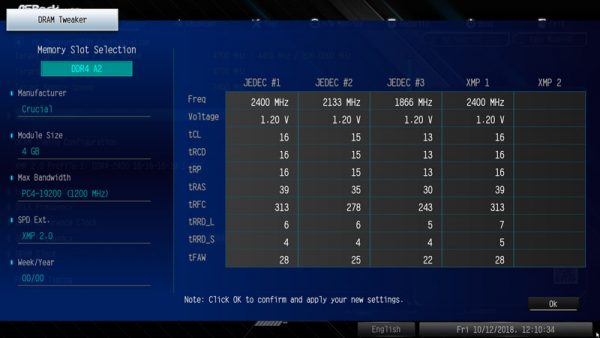
ASRock Z390 Extreme4 voltage settings …
Now we come to the different voltage values that can be set in the BIOS. Although the CPU cannot be overclocked, the Z390 motherboard does provide voltage settings under Voltage Configuration. At the CPU Core/Cache Voltage you can set the value Offset or Fixed Mode. With Fixed Mode, a VCore of up to 1.520V plus -0.100V to +0.200V offset can be set on the Intel Core i7-8700K Test CPU. In addition, the Z390 motherboard has the 1.0V PCH Voltage, VCCIO Voltage, VCCST Voltage, VCCSA Voltage and CPU Load Line Calibration. The DDR4 voltage can also be set in the Voltage menu.
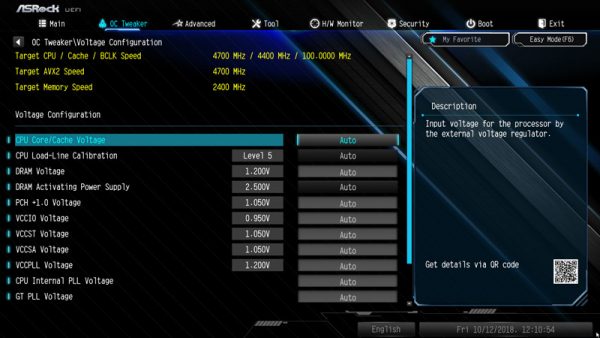
ASRock Z390 Extreme4 even easier overclocking …
If you don’t want to deal with overclocking anymore, you can try your luck with the so-called Load Optimized CPU OC Setting. There you can overclock the system performance automatically in different turbo steps – at least if luck plays along and it is possible with the components and the CPU. Just select the desired level and some components will be overclocked with the Load Optimized CPU OC Setting (or optionally GPU overclocking) to a desired value e.g. Turbo 4.5 GHz, Turbo 4.6 GHz, Turbo 4.7 GHz, Turbo 4.8 GHz or Turbo 5.0 GHz, overclocking couldn’t be easier!
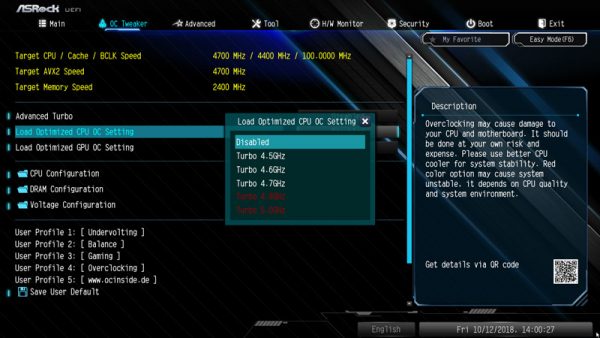
If you prefer to overclock in Windows, you can also use the ASRock A-Tuning Tool to adjust the above mentioned voltage settings and the CPU frequency or, as explained in detail in the Intel OC guide, overclock with the Intel XTU Tool (Extreme Tuning Utility).
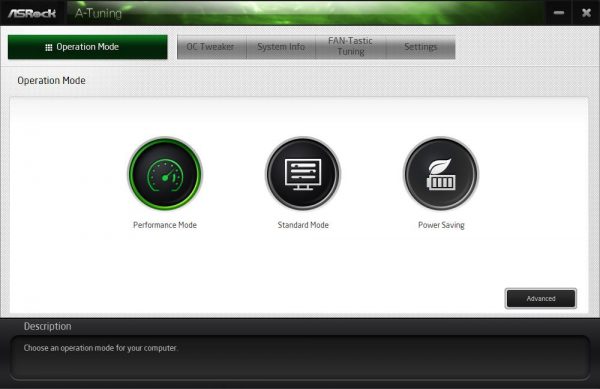
Here you can see some settings of the ASRock A-Tuning Tool.
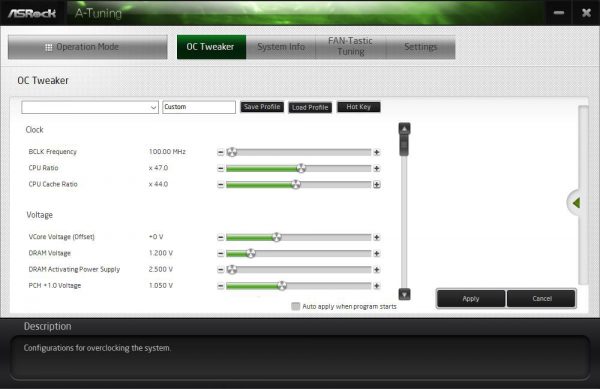
In the ASRock A-Tuning Tool you can also select the Load Optimized CPU OC Setting.
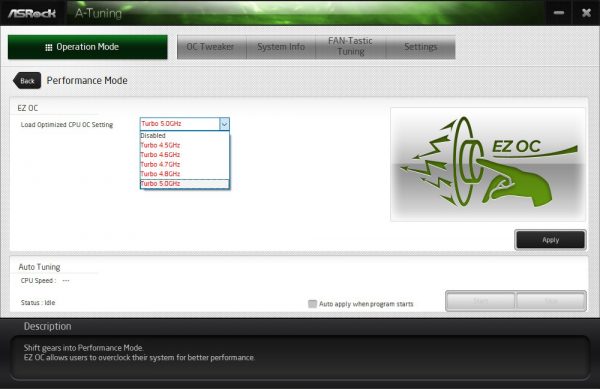
Once the desired settings have been found, you can save up to five different BIOS settings with names in the UEFI under OC Tweaker.
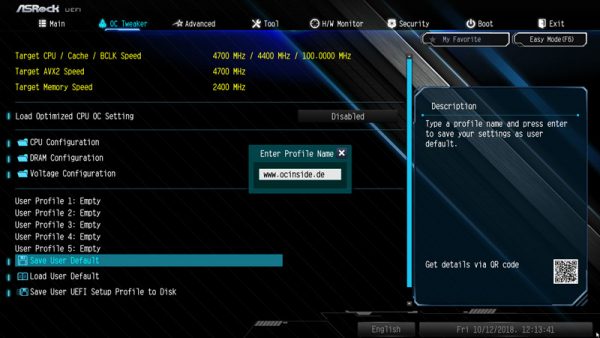
For example, you could store balanced BIOS settings, Undervolting values, Office or Gaming settings as Undervolting, Balance, Gaming and Overclocking user profiles to be able to quickly reload these values at any time.
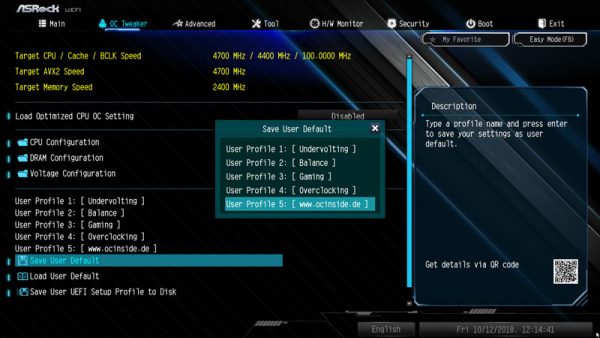
Also interesting is the Save User UEFI Setup Profile to Disk option. Just click it to save your own UEFI settings on the hard drive or an USB stick.
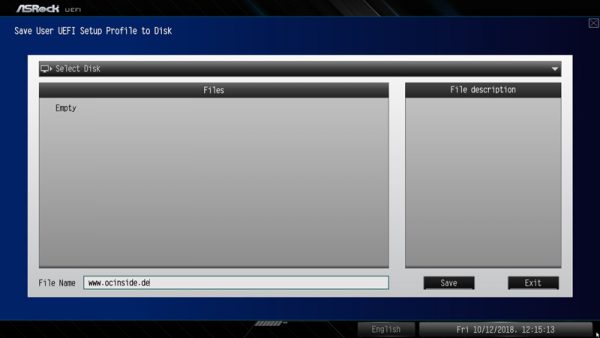
BIOS Undervolting …
The downclocking or undervolting is also tested in this review. It was not possible to lower the Intel Core i7-8700K CPU frequency over the BIOS. You can lower the voltage to reduce the power consumption. Of course, underclocking is like overclocking outside of the manufacturers specification, so it is necessary to have some luck. ASRock gives several options for easy PC undervolting / downclocking. There are many other UEFI settings to choose from, such as CPU Configuration, Chipset, Storage, Intel Thunderbolt, Super IO, ACPI and USB Configuration as well as Trusted Computing.
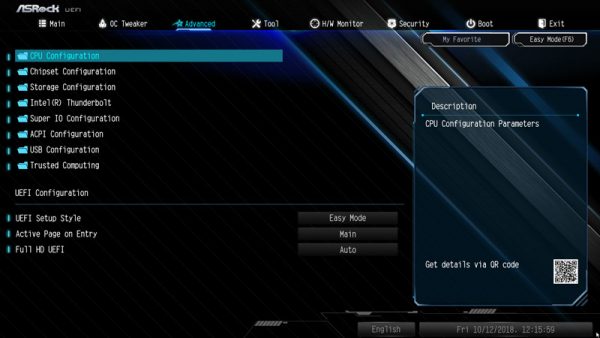
If you want to save power when running your Intel LGA1151 v2 PC or use Intel Virtualization Technology to support multiple, simultaneous operating systems, you should also check the CPU Configuration Menu under Advanced.
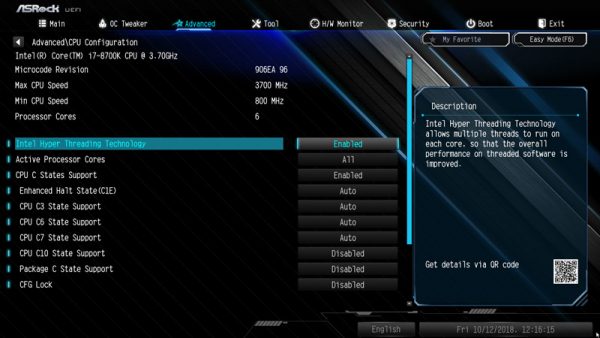
But also the settings in Advanced Chipset Configuration with the individual speeds of the PCIe slots, selecting the first graphics card, etc. are interesting.
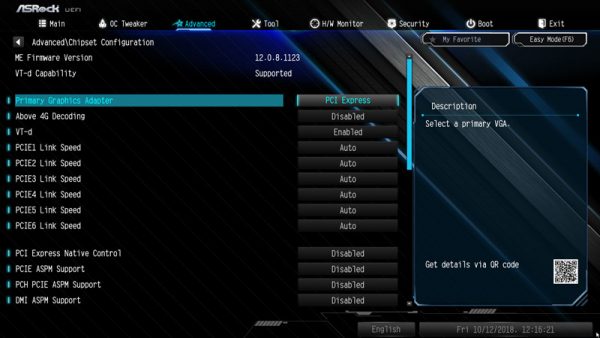
It is even possible to deactivate each USB port of this ASRock Z390 Extreme4 manually.
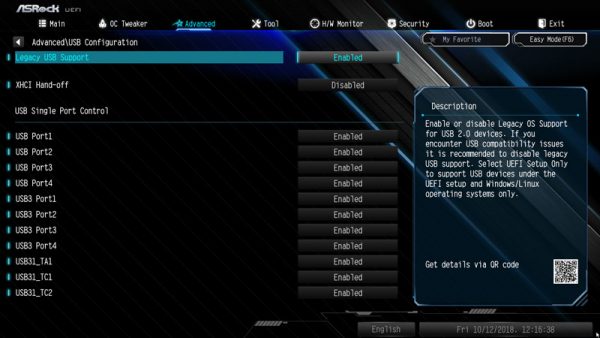
Fan control …
The UEFI Setup of the passive cooled Z390 Extreme4 motherboard also features an extensive temperature controlled fan control. The settings for the fan controller can be found in H/W Monitor directly below the temperature and voltage display.
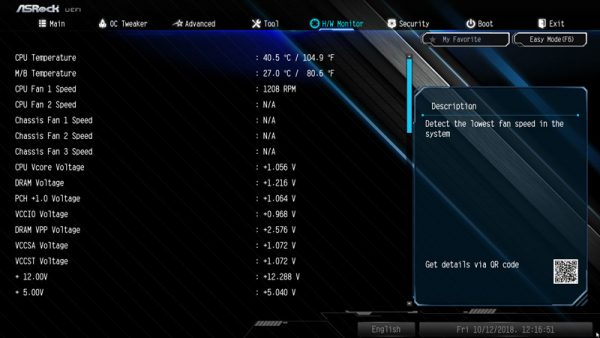
Here are settings for the CPU fan, chassis fans or W_Pump switch.
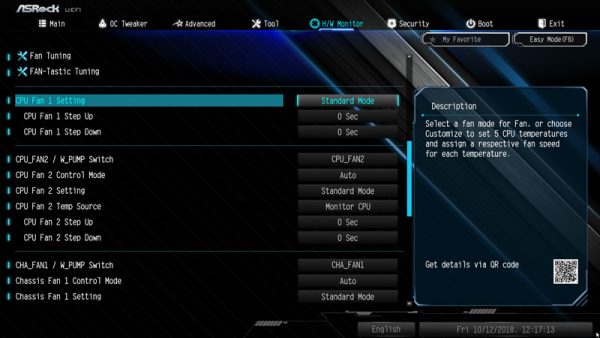
You have the choice between Customize, Silent, Standard, Performance and Full Speed.
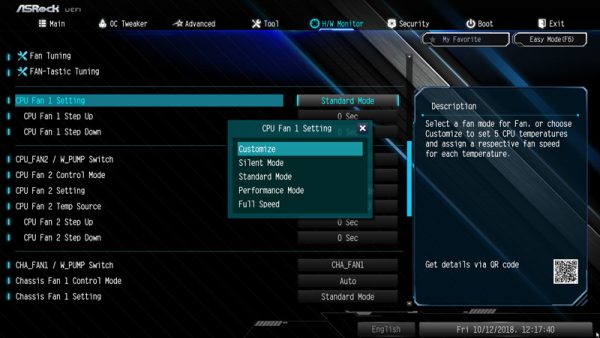
In Customize Mode, several temperature steps are available to which the desired fan speed can then be assigned. The fan settings are changed immediately and can therefore be heard immediately.
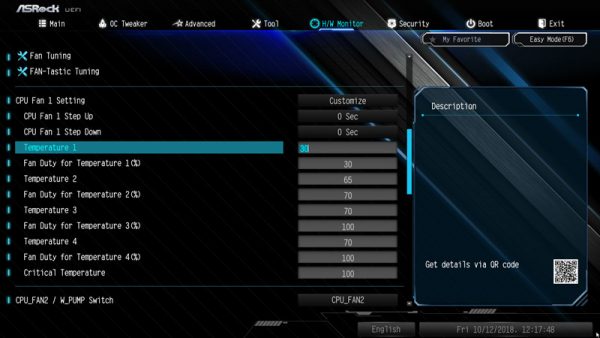
ASRock has also integrated the graphical user interface for controlling the fans in the UEFI setup. The FAN-Tastic Tuning menu item can also be found in the H/W monitor and can be used for all settings. Simply select the respective fan connector on the left side and then select the mode on the right side: Silent, Standard, Performance or Full Speed.
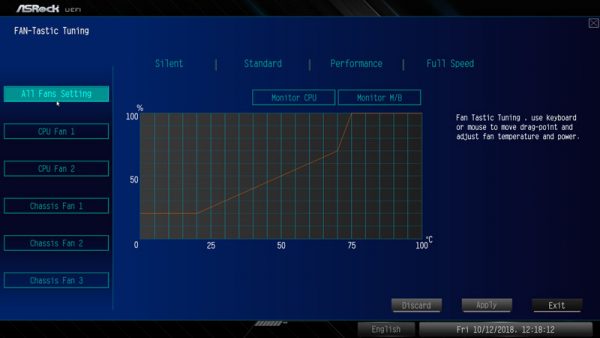
In Customize mode, you can set all values directly in the chart and save.
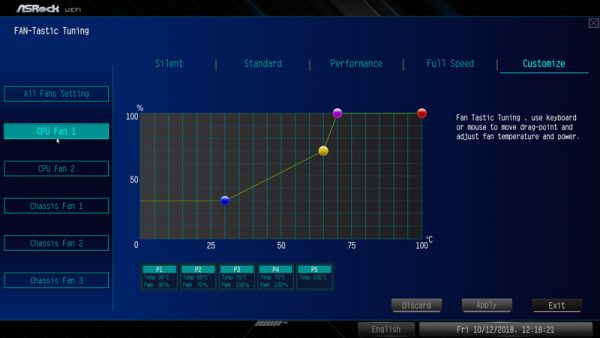
For the chassis fan connectors you can even select, which source you want to use for temperature measurement – Monitor CPU or Monitor Motherboard. Then click on apply and save the values.
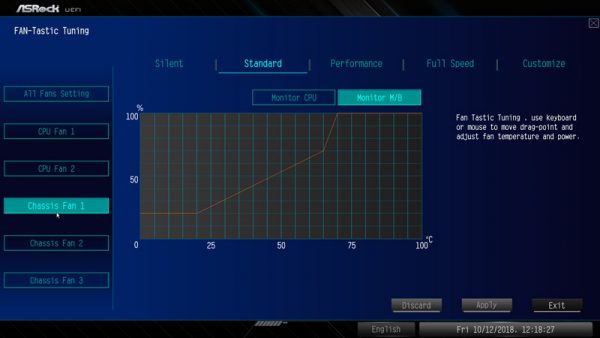
And even the control of the 3-pin chassis fans is possible with the DC/PWM mode switch.
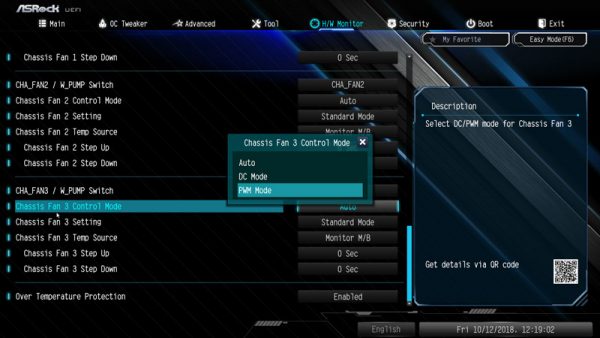
Who would rather set the values in Windows, you can use also the ASRock A-Tuning tool.
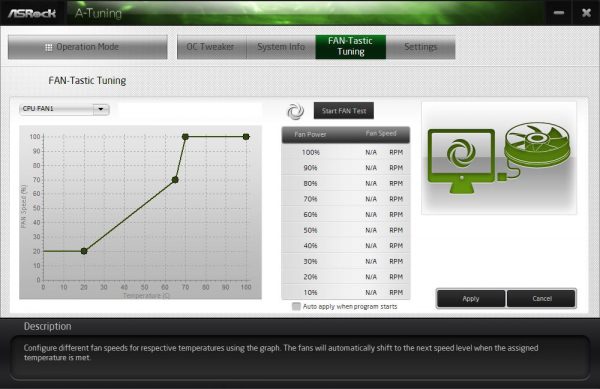
You can usually get along without an expensive Fan Controller, because the fans are controlled with this fan control based on CPU or motherboard temperature.
If everything is set, simply store the settings as usual with the F10 key and confirm with Z or on an English keyboard with Y.
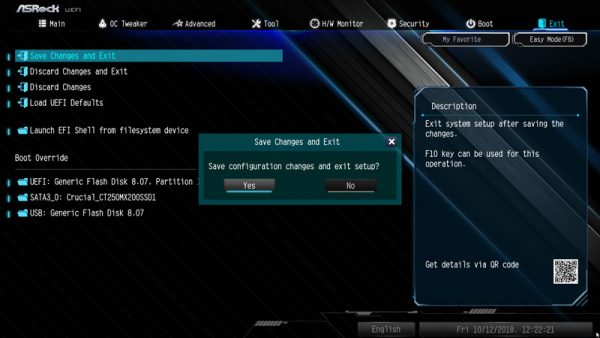
ASRock Z390 Extreme4 energy consumption …

